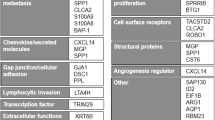Abstract
Lymphatic mapping and sentinel lymph node (SLN) biopsy have been validated in malignant melanoma. We hypothesized that histopathologically negative SLNs may contain occult metastases that can be identified by sensitive molecular approaches such as quantitative reverse transcriptase-polymerase chain reaction (RT-PCR) assay. We previously demonstrated that RT-PCR-based detection of occult metastasis in frozen SLNs upstaged early-stage cutaneous melanomas and that a multiple specific mRNA marker (MM) RT-PCR assay was an independent predictor of disease outcome. We recently developed an MM RT-PCR using electrochemiluminescence (ECL) and quantitative real-time detection assays. These assays can detect occult metastatic melanoma cells in paraffin-embedded (PE) SLNs and are of clinical utility for retrospective analysis of specimens with long-term follow-up. The molecular detection of occult metastasis in PE SLNs has significant clinicopathologic and logistic advantages over molecular analysis of frozen SLNs.
Similar content being viewed by others
References
Morton DL, Thompson JF, Essner R, et al. Validation of the accuracy of intraoperative lymphatic mapping and sentinel lymphadenectomy for early-stage melanoma: a multicenter trial.Ann Surg 1999;230:453–65.
Cochran AJ, Wen DR, Herschman HR. Occult melanoma in lymph nodes detected by antiserum to S-100 protein.Int J Cancer 1984; 34:159–63.
Bostick PJ, Morton DL, Turner RR, et al. Prognostic significance of occult metastases detected by sentinel lymphadenectomy and reverse transcriptase-polymerase chain reaction in early-stage melanoma patients.J Clin Oncol 1999;17:3238–44.
Kuo C, Hoon DSB, Takeuchi H, et al. Prediction of disease outcome in melanoma patients by molecular analysis of paraffin-embedded sentinel lymph nodes.J. Clin Oncol 2003;21:3566–72.
Hoon DS, Bostick P, Kuo C, et al. Molecular markers in blood as surrogate prognostic indications of melanoma recurrence.Cancer Res 2000;60:2253–7.
Sarantou T, Chi DDJ, Garrison DA, et al. Melanoma-associated antigens as messenger RNA detection markers for melanoma.Cancer Res 1997;57:1371–6.
Miyashiro I, Kuo C, Huynh K, et al. Molecular strategy for detecting metastatic cancers with use of multiple tumor-specific MAGE-A genes.Clin Chem 2001;47:505–12.
Author information
Authors and Affiliations
Corresponding author
Rights and permissions
About this article
Cite this article
Takeuchi, H., Taback, B., Kuo, C. et al. Clinicopathological utility of molecular staging for melanoma patients undergoing sentinel lymphadenectomy. Annals of Surgical Oncology 11 (Suppl 3), 152S–155S (2004). https://doi.org/10.1007/BF02523620
Received:
Accepted:
Issue Date:
DOI: https://doi.org/10.1007/BF02523620




